There are times when you need to format a hard drive or SSD on your Windows 11 PC. Be it for giving away the storage device to someone else or erasing all the data to start from scratch. Formatting a storage disk reduces the chances of faulty disk sectors, common disk errors, and defragments the disk. So to learn how to format a hard drive or SSD in Windows 11, we have come up with this guide with four simple methods. You can perform a quick format, erase data from all sectors, create primary partitions, and a lot more. So without any delay, let’s go ahead and learn how to format HDD or SSD in Windows 11.
Format a Hard Drive or SSD in Windows 11 (2022)
In this guide, we have included four ways to format a hard drive or SSD in Windows 11. From File Explorer to Settings, Disk Management, and Command Prompt, we have mentioned all the common methods. Expand the table below and move to any section you want.
1. Format a Hard Drive or SSD in Windows 11 from File Explorer (Easiest Method)
The easiest and fastest way to format a hard drive or SSD in Windows 11 is through the Windows 11 File Explorer. It works for external as well as internal drives and is much faster than other techniques. Here’s how this method works:
1. Press the Windows 11 keyboard shortcut “Windows + E” to open File Explorer. Here, right-click on the hard drive or SSD that you have plugged into your computer and select “Format” from the context menu.
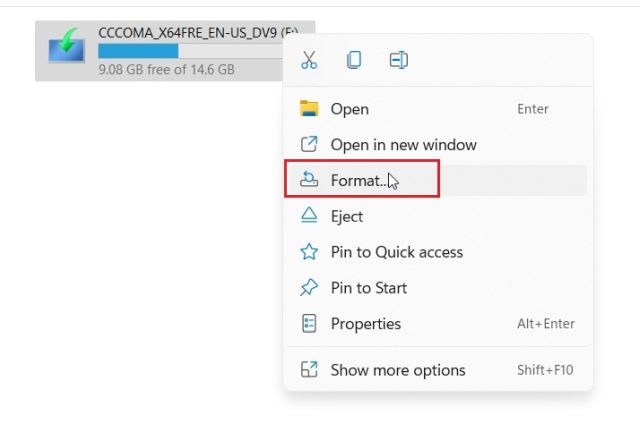
2. Next, in the pop-up window that opens up, make sure “File system” is selected as “NTFS“, which is a Windows file system. If you want the hard drive to be compatible with macOS as well, you can choose “FAT32” or “exFAT” file systems.
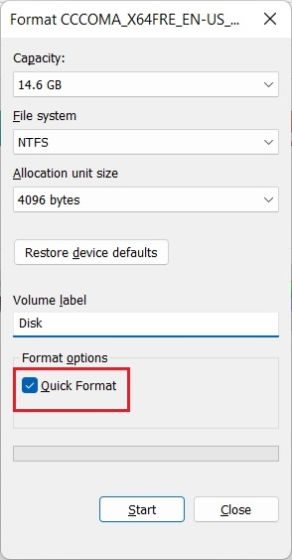
3. Don’t change the allocation size and let it be set by default. Then, enable the checkbox for “Quick Format” under “Format Options” and click on “Start” to format the storage disk. Then, within seconds, you will have formatted your HDD or SSD in Windows 11.
Note: Quick Format is faster, but it does not erase the data entirely. Instead, it simply removes the references to memory, making them inaccessible. The data will be overwritten when you start adding new files in the storage disk. If you want to entirely wipe the data from all sectors, uncheck Quick Format. This step comes in handy when you wish to give away the storage device to someone else, as it makes it harder to recover the deleted data using third-party software.
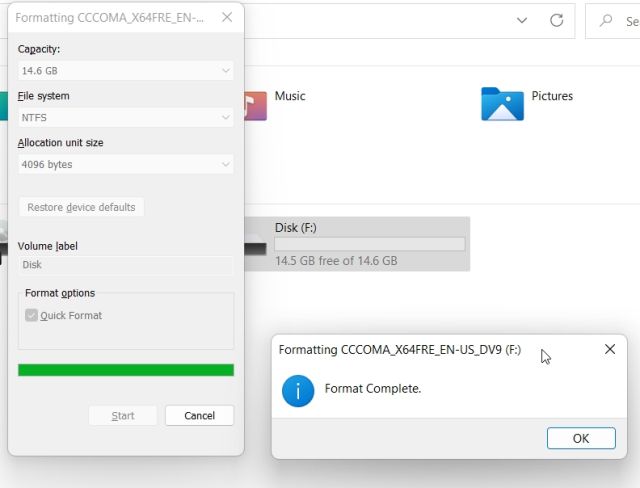
2. Format a Hard Drive or SSD in Windows 11 from Settings
Apart from the File Explorer, you can also format a hard drive or SSD in Windows 11 from the Settings app. Here’s how to go about it:
1. Simply press “Windows + I” to open the Settings app in Windows 11. Here, navigate to System -> Storage.
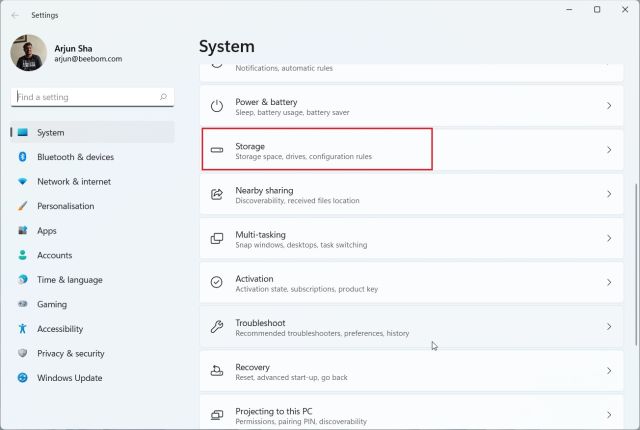
2. Next, expand the “Advanced storage settings” option and select “Disks & volumes“.

3. Here, click on the primary partition under the HDD or SSD you want to format. Then, select the “Properties” option.

4. Next, click on “Format“.

5. In the pop-up box that opens, set a name under the “Label” field and choose “NTFS” as the file system. Finally, click on “Format“, and you are done. This is how you can format a hard drive or SSD in Windows 11 using the Settings.
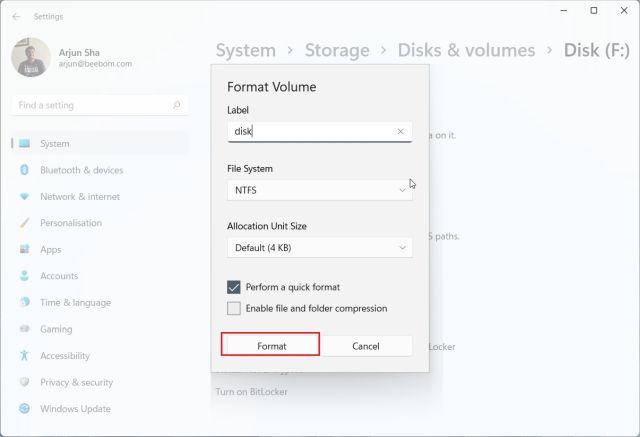
3. Format a Hard Drive or SSD in Windows 11 Using Disk Management
While Disk Management may look a bit daunting to many, it’s actually the best way to format a hard drive or SSD in Windows 11. It’s my favorite method to format hard drives, SSDs, SD cards, thumb drives, and more. With that said, let’s begin.
1. Press “Windows + X” or right-click on the Start menu to open the Quick Links menu. Now, click on “Disk Management“.
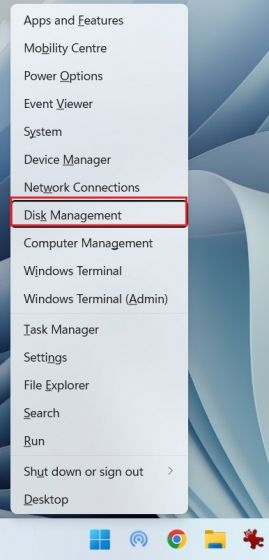
2. In the Disk Management window, you will find the connected hard drive or SSD storage, generally marked as “Disk 1” or above, at the bottom. On the right side, it will show the primary partition. Right-click on this and choose “Format“.
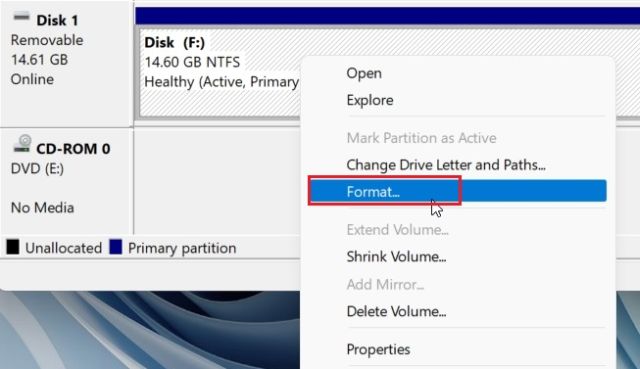
3. Next, give a name to the HDD or SSD under the “Volume label” field and click on “OK“. You can uncheck “Perform a quick format” if you want to actually erase all the data instead of memory references.
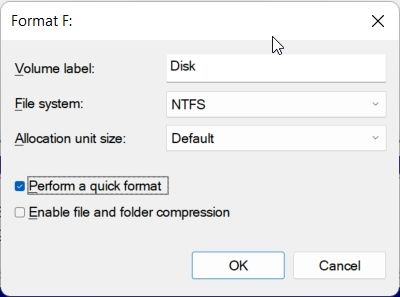
4. And that’s how you can format a hard drive or SSD in Windows 11 with Disk Management.

4. Format a Hard Drive or SSD in Windows 11 From Command Prompt (CMD)
You can also format a hard drive or SSD in Windows 11 using the Command Prompt terminal. You need to execute the popular diskpart command to format the disk, drive, or partition. That said, let’s look
1. Press the Windows key and type “cmd” in the search box in the Start Menu. Then, click on “Run as administrator” in the right pane to open the Command Prompt window. In case you want to always run CMD with Admin privilege, you can head over to our linked article.

2. Next, in the Command Prompt window, type the below command and hit Enter to open DiskPart.
diskpart
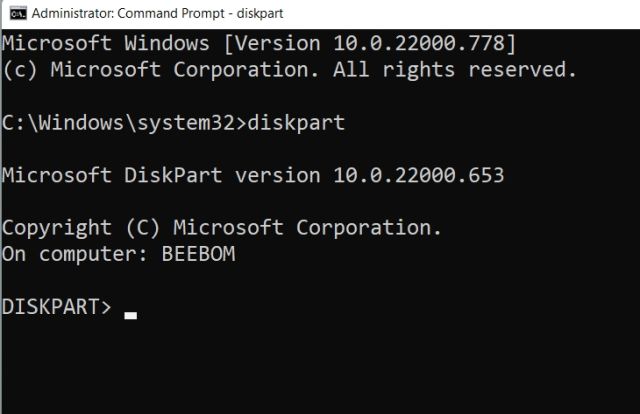
3. Next, run the below command to list all the HDDs and SSDs connected to your Windows 11 computer. Note down the disk number (shown under the second column) of the HDD you want to format. Make sure to choose the correct disk number as picking the wrong disk will result in an inadvertent data wipe.
list disk
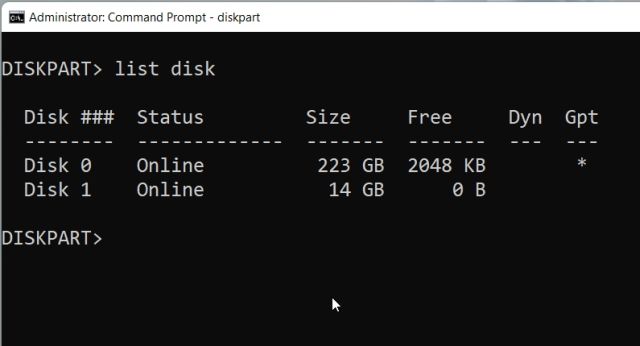
4. Next, choose the disk by running the below command. Here, replace X with the disk number, you noted above.
select disk X

5. Finally, run the below command to format the hard drive or SSD in Windows 11.
clean

6. Now, you need to initialize the disk in order to use it. For that, run the below commands one by one. In the fifth command, where you assign the drive letter, replace X with your preferred letter. When you’re done, you can use the formatted hard disk or SSD through File Explorer.
create partition primary select partition 1 active format FS=NTFS quick assign letter=X exit
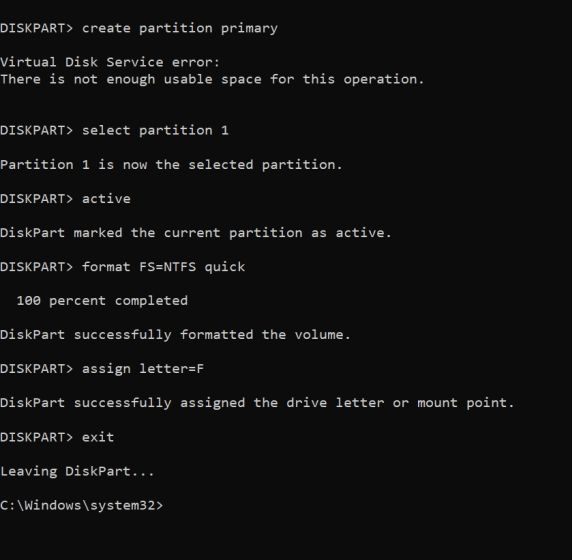
Erase Hard Drive or SSD in Windows 11 in Four Easy Ways
So this is how you can erase, format, create a partition, and initialize the disk on Windows 11. I love the fact that Windows 11 has multiple built-in tools to format a hard drive or SSD storage disk. You can perform a quick format or uncheck it and erase the whole disk sector-by-sector for complete peace of mind. Anyway, that’s all for this guide. In case you’re looking for a way to uninstall apps in Windows 11 from system programs to hidden apps, you can follow our article. And for those looking to convert the disk from MBR to GPT without any data loss in Windows 11/10, head to our detailed tutorial to check out the step-by-step process. If you have any questions, do let us know in the comment section below.






